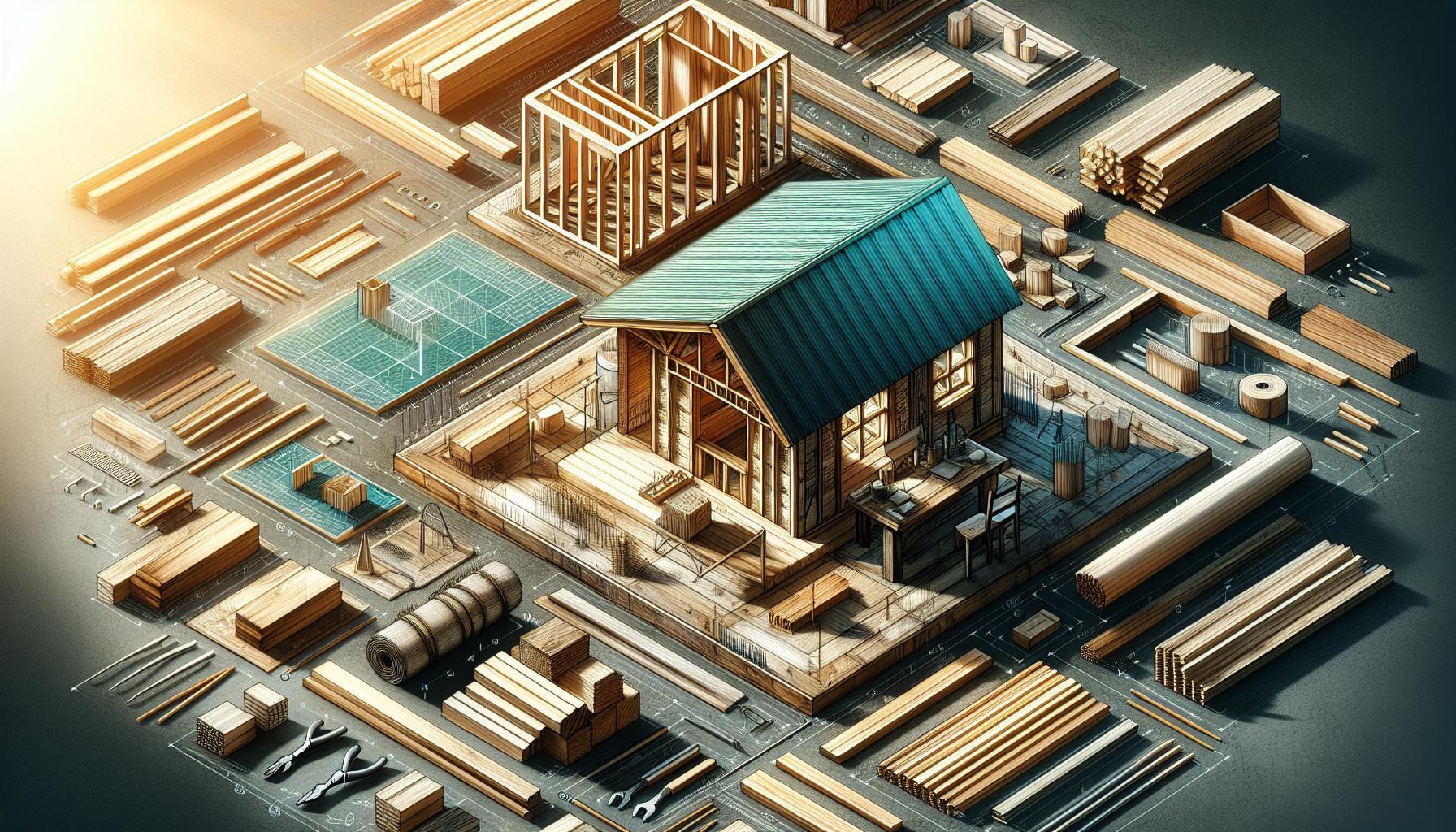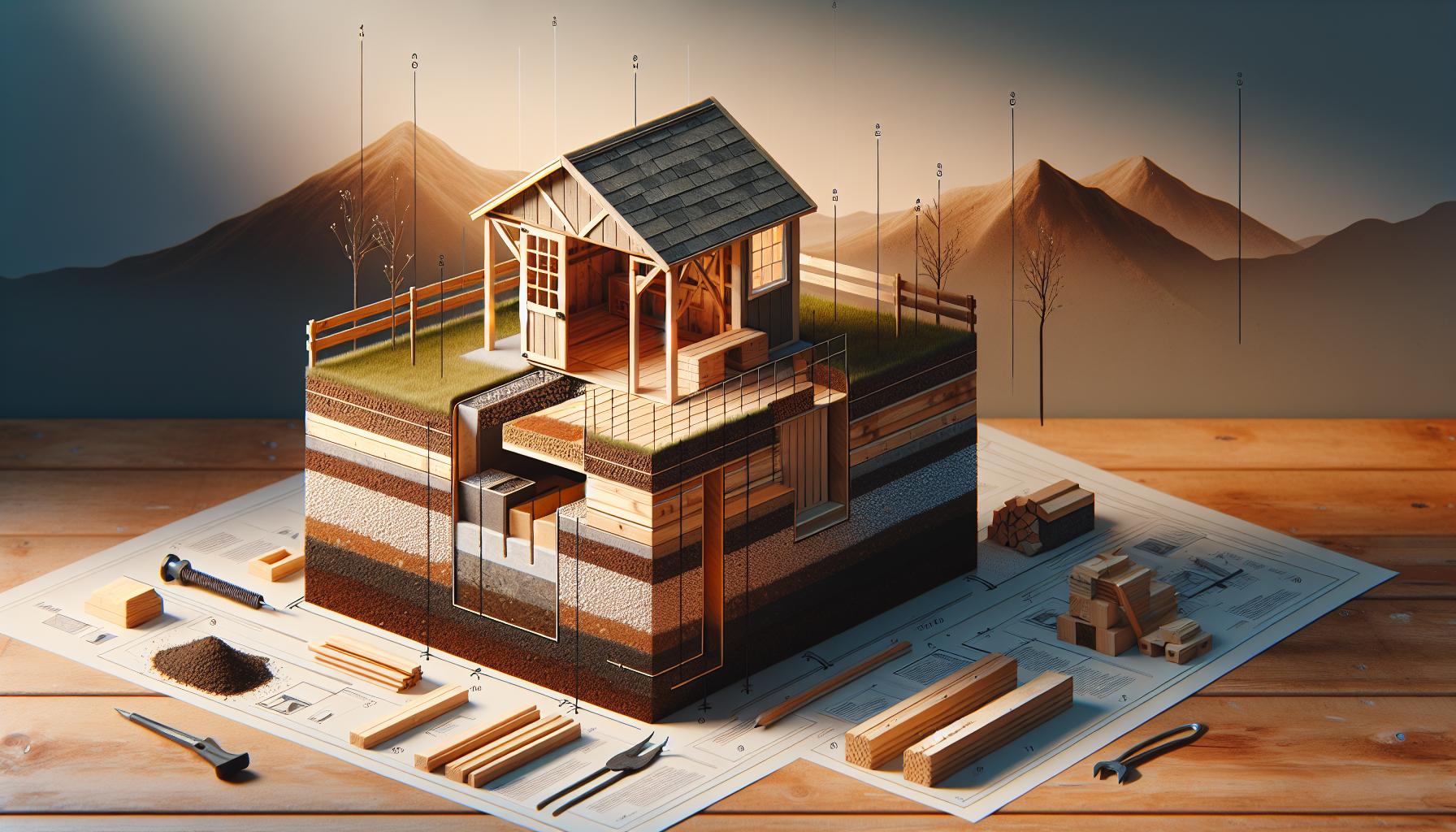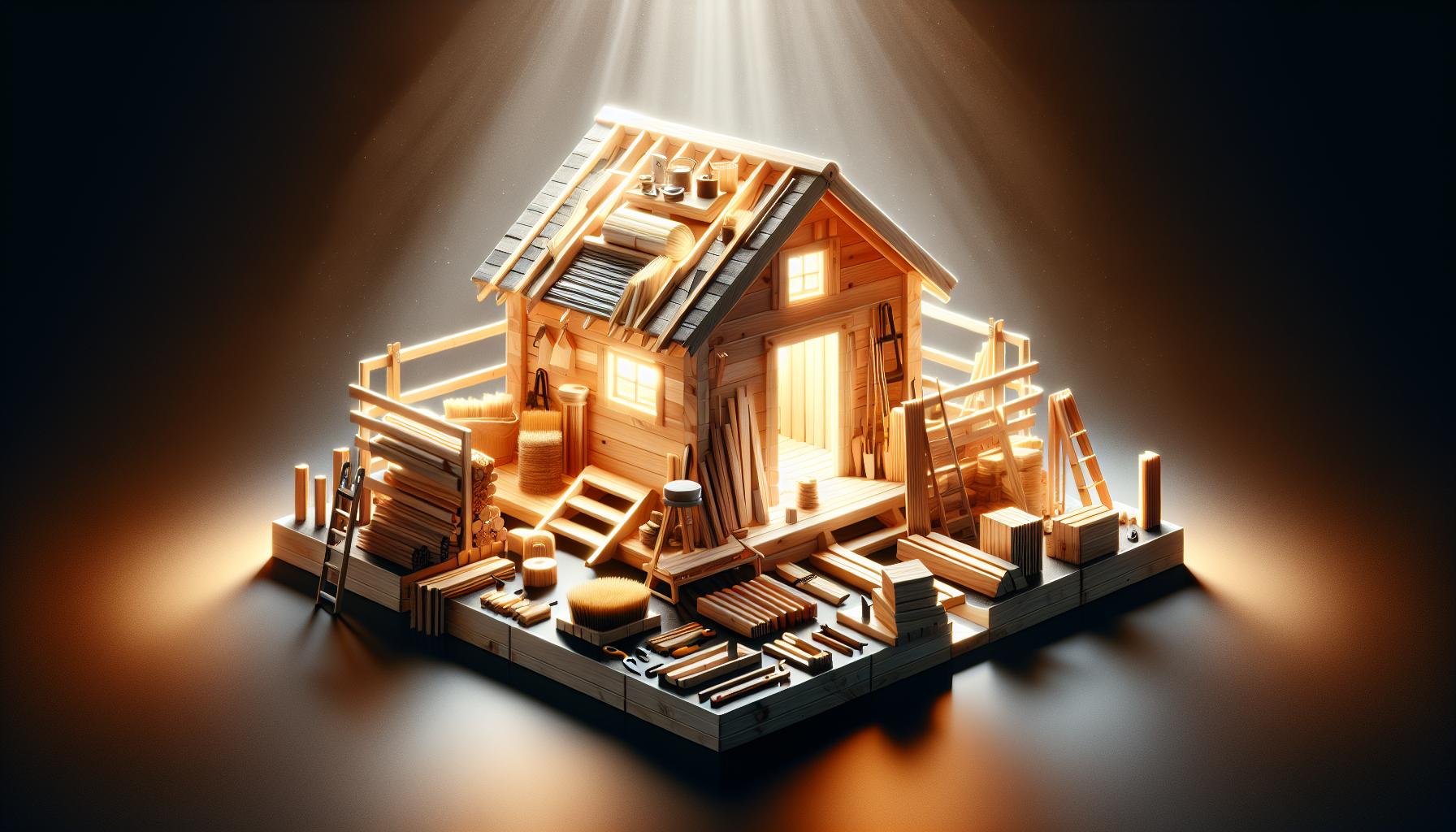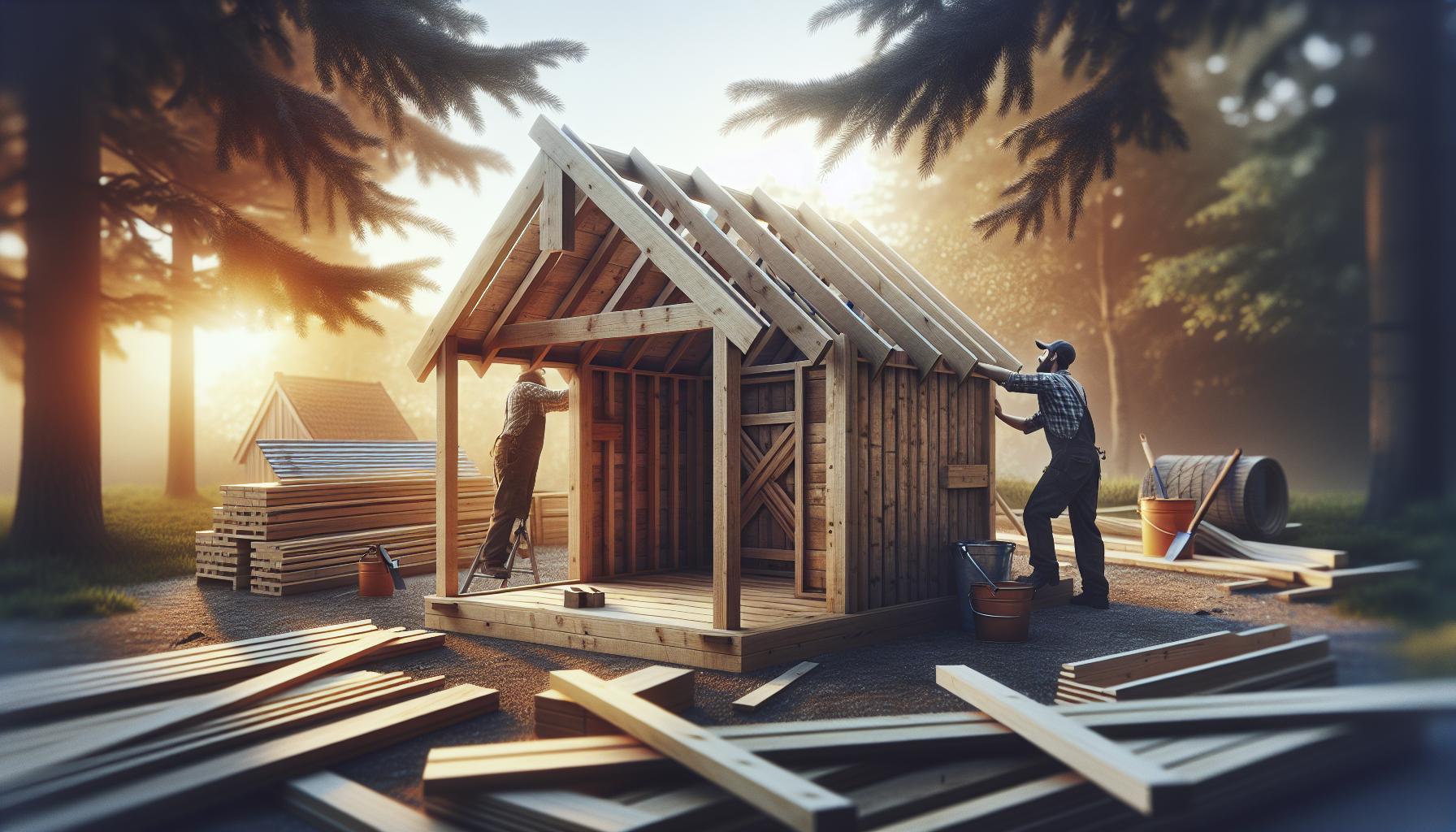Choosing the right base for your shed is crucial to ensure stability adn longevity, especially when considering varying soil types and environmental conditions. With a range of foundation options available—from concrete slabs to gravel pads—understanding the advantages and disadvantages of each will help you make an informed decision, safeguarding your investment and enhancing your outdoor space.
Understanding Different Soil Types and Their Impact on Shed Foundations
Understanding the unique characteristics of different soil types is crucial when considering the best base for your shed foundation. The type of soil beneath your shed influences not only the structural integrity but also the longevity of the foundation. Each soil type—whether it’s clay, silt, sand, or gravel—behaves differently under load and environmental conditions. This understanding can help you make informed decisions to ensure stability and durability.
Soil Types and Their Properties
- Clay: known for its moisture retention,clay can be problematic due to its tendency to expand and contract with changes in moisture levels. This movement can lead to cracking in foundation structures unless properly managed.
- Silt: Similar to clay, silt can also retain moisture, but it combines the qualities of sand and clay.While it provides a reasonably stable base, its susceptibility to erosion can be a concern, particularly in heavy rainfall.
- Sand: Sand drains well and offers solid support, making it an excellent choice for shedding water away from the foundation.However, poorly compacted sand can settle over time, leading to uneven support.
- Gravel: Gravel is often the preferred choice for foundation bases due to its excellent drainage properties and ability to resist frost heaving. It provides a stable, well-drained support layer that minimizes the risk of moisture damage.
Choosing the right foundation material for your shed involves understanding how these soil types interact with seasonal weather patterns. Such as, in regions prone to freezing, a frost-proof foundation is necessary to prevent heaving. Well-graded gravel is often the moast effective material for such environments, as it reduces frost effects and offers a reliable base for the shed structure [[2](https://diy.stackexchange.com/questions/284612/what-material-should-be-used-to-fill-a-raised-shed-foundation)].
To help visualize the impact of different soil types, consider the following table summarizing their key characteristics:
| Soil Type | Drainage | Expansion Risk | Ideal Use |
|---|---|---|---|
| Clay | Poor | High | Not recommended without stabilization |
| silt | Moderate | Moderate | Prepared foundations, possibly hydraulic issues |
| Sand | Good | Low | Solid water-draining base |
| Gravel | Excellent | Very low | optimal choice for stability |
By evaluating the soil type in your area, you can better choose your shed foundation type, ensuring that your structure remains sturdy and functional throughout its lifespan. this proactive approach not only maximizes your shed’s performance but also saves you from future complications and maintenance efforts related to poor foundation choices.
Popular Foundation Types for Sheds: Pros and Cons Explained
Building a sturdy shed requires careful consideration of the foundation type, as this can substantially impact the longevity and stability of the structure. Various shed foundation types serve different purposes, accommodating unique soil conditions and personal preferences. Understanding the pros and cons of each option will help you select the best foundation for your project and ensure your shed withstands time and weather.
Concrete Foundations
Concrete foundations are among the most durable options available. When installed properly, they are impervious to pests and can handle heavy loads without deforming. Here are some key points:
- Pros:
- long-lasting and robust against environmental factors.
- Resistant to insect damage.
- Requires minimal maintenance after installation.
- Cons:
- Higher initial cost compared to other materials.
- Installation can be labor-intensive and requires time to cure.
Gravel Foundations
Gravel is a cost-effective and popular choice for many shed owners,thanks to its excellent drainage properties. Using a gravel base helps prevent moisture buildup, which can lead to rot and mold over time.
- Pros:
- Easy to install and modify if necessary.
- Good drainage, helping to protect the structure.
- Cost-effective for smaller sheds.
- Cons:
- Less stability than a concrete foundation for larger or heavier structures.
- May require periodic replenishment of gravel.
Plastic Shed Bases
Plastic foundations, often marketed as shed bases, are becoming increasingly common due to their lightweight and easy-to-install nature. They function by interlocking panels that can be filled with gravel or soil.
- Pros:
- Very lightweight and easy to handle.
- Quick to install with minimal excavation required.
- Can be reused, making them environmentally friendly.
- Cons:
- May not support heavy structures effectively.
- Can shift or sink over time if not installed correctly.
Choosing the right shed foundation type is a critical decision that should align with your soil characteristics, budget, and long-term plans for the shed. Consider these factors carefully to enhance the durability and functionality of your outdoor space.
How to Choose the Right Foundation Based on Your Shed Size
Choosing the right foundation for your shed can significantly affect its longevity and stability. The foundation type not only supports the weight of your structure but also determines how well it withstands environmental challenges like moisture and soil movement. For different shed sizes, the requirements can vary, so it’s essential to match the foundation to your specific needs.
Small to Medium Sheds
For sheds measuring up to 10×10 feet, a simple and cost-effective solution is using concrete blocks. these blocks should be placed at each corner and in the center of the sides to ensure stability. You can also use gravel or compacted earth as a raised base. Here’s a quick guide:
- Foundation Type: Concrete blocks or compacted gravel
- Depth: 4 to 6 inches below ground level
- Preferred Area: Dry, well-drained soil
These smaller foundations are relatively easy to install and provide sufficient support while allowing water drainage, which is critical for preventing rot.
Large Sheds
For larger structures, sizes over 10×12 feet, the stakes rise in terms of materials and complexities. These sheds typically require a more robust foundation to handle greater weight and potential heavy-use scenarios. You might consider a reinforced concrete slab, which is ideal for storing heavier items or equipment.
- Foundation Type: Reinforced concrete slab
- Thickness: At least 4 inches for general use, up to 6 inches if you plan to store heavy machinery
- Installation tip: Ensure proper leveling and grading for optimal drainage
In colder climates, it’s wise to dig deeper to prevent frost heave, which coudl disturb the slab’s integrity.
Considerations Based on Soil Type
The nature of your soil can play a crucial role in choosing the right foundation.For sandy or loose soils, consider using a deeper foundation, such as post-and-beam, which helps distribute the load more evenly. Conversely,clay soils often expand and contract; therefore,a solid,non-permeable slab is highly advisable to reduce shifting.
| Soil Type | Recommended Foundation | Key Characteristics |
|---|---|---|
| Sandy | Concrete post-and-beam | Good drainage, may require depth for stability |
| Clay | Reinforced concrete slab | Stable but prone to expansion; needs weight distribution |
| Loamy | Cinder blocks or gravel base | Well-drained, supports lighter structures effectively |
Ultimately, matching your foundation to the shed size and soil type ensures not only the structural integrity of your shed but also its usability and lifespan. remember, investing time and resources into a proper foundation will pay off in the long run, keeping your investment secure and functional.
Preparing Your Site: Essential Steps for a Solid Foundation
Preparing your site properly is crucial for establishing a sturdy and durable foundation that supports your shed thru a variety of conditions. The initial steps you take will ultimately determine the success of your project and the longevity of your structure. One of the most crucial factors is understanding the specific soil type on your property. Each type—whether it be clay, sandy, or loamy—has unique drainage properties that affect how stable your shed will be over time.
To begin, it’s vital to assess the area where you plan to build. Start by clearing the site of any debris, vegetation, or old structures that could impede construction. Once you have a clean slate, you can start with the following essential steps:
- Measure the Area: Accurately mark the dimensions of your shed using stakes and string. Ensure that your layout is square by measuring the diagonals.
- Check for Level Ground: Use a level to gauge whether the ground is flat. If your site has slopes or dips, you may need additional excavation or leveling to create a stable base.
- Excavate if Necessary: Depending on your soil type, you may need to dig down several inches to reach a compacted layer. This is especially important for clay soils that retain water.
- Opt for Proper Drainage: Incorporate a drainage system, such as a gravel trench, to prevent water accumulation around your foundation. Good drainage will reduce the risk of erosion and foundation displacement.
After excavation, consider creating a compacted base to enhance stability. Using materials like gravel can provide a strong,draining foundation. If you’re opting for a concrete slab foundation, ensure that you have laid forms properly, accounting for thickness and reinforcement bars as needed.
For a more detailed examination of your options, you can refer to a comparative table of shed foundation types based on soil compatibility and structural needs:
| Foundation Type | Best Soil Type | Drainage Needs | Typical Stability Ratings |
|---|---|---|---|
| Concrete Slab | All | Moderate | High |
| Gravel Pad | Sandy, Loamy | Low | Medium to High |
| wood Skids | Mixed | High | Medium |
By meticulously preparing your site and choosing the right shed foundation types, you’ll set the stage for a resilient structure that can withstand the test of time. If properly done, these initial preparations can minimize future maintenance worries and enhance the functionality of your shed.
Common challenges in Shed Foundation Construction and How to Overcome Them
Establishing a solid foundation is crucial to the longevity and durability of your shed. However, several common challenges can arise during the construction of a shed foundation, and understanding how to navigate these issues is key to ensuring a successful build. One major challenge is the variability of soil conditions. Different types of soil, such as clay, sand, or loam, can influence how stable your foundation will be. As a notable example, clay tends to retain moisture, leading to shifts that can compromise the foundation over time. To mitigate this, it’s essential to conduct a soil test before beginning your project, ensuring you choose the right foundation type suited to your soil’s characteristics.
Another frequent issue is the risk of water pooling around the foundation, which can lead to rot, mold, and structural damage. Proper drainage is imperative in preventing water accumulation.Consider elevating your shed foundation by using materials like concrete blocks or an adjustable metal base, which can definitely help keep the structure above ground level and promote better water flow away from the foundation. In addition, incorporate a sloped grading around the shed to direct water drainage effectively.
Uneven Ground and Leveling
Building on uneven ground poses its own set of challenges.An unlevel base can result in warped walls and compromise the integrity of your shed. To resolve this, you may need to excavate the area and fill it with gravel or level the ground using a compacting method.An adjustable foundation system can also be beneficial here, allowing you to modify the height of the base once it’s in place.
Material Selection and Durability
Choosing the right materials for your foundation can greatly influence your shed’s lifespan. wooden skids, such as, might potentially be cost-effective but can decay quickly if not treated properly. Rather, consider more durable options like concrete piers or treated lumber, which provide superior resistance against the elements. Always consult with local building codes to ensure your selected materials and methods meet regulations relevant to your area.
By anticipating these common challenges in shed foundation construction and employing effective solutions, you can create a robust base that will support your shed for years to come. Leveraging knowledge from articles on shed foundation types can further enhance your understanding and planning, ensuring you select the best base for your soil and structure.
DIY Foundations: Materials and Techniques that Stand the Test of Time
When it comes to constructing a durable shed, the foundation is one of the most critical components that can impact its longevity and functionality. Opting for DIY foundations allows homeowners not only to customize their projects based on specific soil conditions but also to save on costs while ensuring their shed stands the test of time. Various materials and techniques can be utilized, making it important to choose wisely according to your environment and shed design.
Common Materials for Shed Foundations
The foundation of your shed can be built using a variety of materials, each with its distinct advantages. Here are some popular options:
- Concrete Blocks: Often used for their strength and stability, concrete blocks provide an ideal base that resists moisture. They are best suited for level ground and can elevate the shed to prevent water damage.
- Pressure-Treated Wood: This option is often used for a more traditional look. Pressure-treated lumber is resistant to rot and insect damage, making it a reliable choice for skids or beams under your shed.
- Gravel pads: A gravel foundation is simple and effective. By digging out a level area and filling it with gravel, you provide excellent drainage while keeping your shed elevated.
- Concrete Slabs: For the ultimate in durability, a poured concrete slab ensures your shed remains sturdy and secure against shifting soil or extreme weather.
Techniques to Ensure Stability
While choosing appropriate materials is vital, employing the right techniques during installation is equally essential to ensure stability and longevity. Here are some key techniques to keep in mind:
- Site Planning: clear the area of debris and level the ground as much as possible. This helps prevent uneven settling after the foundation is installed.
- proper Drainage: Ensure that your foundation allows for adequate water runoff. This may involve sloping the ground away from your shed to facilitate drainage.
- Anchor the Shed: Use anchors or brackets to secure your shed to the foundation,especially in areas prone to high winds. This adds an extra layer of protection.
- Regular Maintenance: Periodically check for signs of rot or erosion around the foundation. Early detection of issues can prevent more notable problems down the line.
By carefully selecting materials and implementing effective techniques, you can create a robust foundation that supports your shed for years to come. Each method has its strengths, so consider local soil conditions, climate, and the intended use of the shed when deciding on the most suitable approach.
Maintenance Tips for Keeping Your Shed Foundation in Top Shape
Maintaining a strong foundation is crucial for the longevity and functionality of your shed. Without proper upkeep, even the best shed foundation types can succumb to wear and tear, which can lead to costly repairs or replacements.Regular maintenance ensures that your shed remains structurally sound and capable of withstanding environmental challenges.Here are essential tips to keep your shed foundation in top shape, ensuring that it serves you well for years to come.
Regular Inspections
Routine inspections are vital for identifying potential issues before they escalate. Check for signs of sinking or settling, which can indicate inadequate drainage or shifting soil. Look for cracks in the foundation, signs of water pooling, and any areas where the soil has eroded or shifted away from the shed base. Addressing these concerns promptly can prevent more severe damage.
Manage Drainage Effectively
Effective drainage is a cornerstone of foundation maintenance. Ensure that the ground slopes away from the shed to avoid water accumulation around its base. If necessary, consider installing a drainage system or French drains to direct water away. Regularly clear any debris that may obstruct gutters or downspouts, ensuring they function effectively to channel water away from the foundation.
Secure the Foundation
Depending on the type of shed foundation—be it concrete slabs, piers, or wood skids—securing the foundation properly is crucial. For concrete slabs, regularly check for peeling or cracking, and consider applying a sealant to protect against moisture. If your shed is on piers, examine the beams for any signs of rot or pest damage, and replace them if necessary. For wooden bases, apply protective treatments to inhibit rot and maintain structural integrity.
Seasonal Maintenance
As seasons change, so do the conditions affecting your shed foundation. Spring and fall are ideal times for comprehensive checks. Here’s a seasonal maintenance checklist:
- Inspect and repair any damage caused by winter weather or heavy rains.
- Clear out any debris, such as leaves or snow, that could trap moisture against the foundation.
- Examine the surrounding soil for signs of saturation or erosion.
- Consider releveling or adding soil to any low areas around the shed that may lead to pooling.
By following these maintenance tips,you can significantly extend the lifespan of your shed foundation,ensuring it remains a reliable structure for your storage and workspace needs.
Innovations in Shed Foundation Design: What You Need to Know
In the evolving landscape of shed construction, foundation design innovations are reshaping how enthusiasts approach building projects.With advancements in materials and techniques,today’s shed foundation types provide enhanced stability,durability,and ease of installation. Recognizing the right foundation is critical not just for structural integrity,but also for extending the lifespan of your shed against the elements.
smart Material Choices
One of the most significant innovations in shed foundation design is the utilization of smart materials. Recent developments have introduced composite materials that resist rot and insect damage, thereby enhancing longevity compared to traditional wood. For instance, using recycled plastic lumber for sills instead of typical timber can significantly reduce maintenance needs. Opting for geotextile fabric in gravel foundations improves drainage and prevents weeds, thus maintaining a cleaner and sturdier base. Consider these options for a more sustainable and effective approach:
- Composite Lumber: Long-lasting and low-maintenance.
- Geotextile fabric: Enhances drainage and prevents weed growth.
- Steel Reinforcement: Adds rigidity and improves resistance to settling.
Adapting to Soil Conditions
Innovation in shed foundations also caters to diverse soil conditions. As an example, advancements in helical piers provide a viable option for areas with unstable soils. These screw-like structures can be anchored deep into the ground, offering stability that traditional methods may lack. This adaptability allows for precise adjustments depending on the soil’s load-bearing capacity, ensuring your shed remains upright and durable even in challenging environments. when selecting a foundation type, consider conducting a soil test to identify your site’s specific needs, thus ensuring the best fit for your shed foundation.
Prefabricated Solutions
The rise of prefabricated foundation kits is another exciting advancement that streamlines the building process. These kits often include pre-cut materials and easy-to-follow instructions that minimize the need for advanced carpentry skills. This approach not only saves time but also reduces waste associated with traditional construction methods. Homeowners can efficiently set up their shed foundations using leveling systems integrated into the kits, which automatically adjust to ensure a flat surface, even on uneven terrain.
By staying informed about these cutting-edge innovations within shed foundation types, you can select the best base for your soil and structure, leading to greater satisfaction and functionality from your finished project.
FAQ
What are the different shed foundation types available?
The most common shed foundation types include concrete slabs, wood skids, gravel pads, and block foundations. Each type suits different soil conditions and shed uses.
Choosing the right foundation is crucial for ensuring your shed remains stable over time. As an example, concrete slabs provide a strong, long-term base, while gravel pads offer excellent drainage for wetter areas. Understand your specific site conditions to select the ideal type.
How do I choose the best base for my soil and structure?
To choose the best base for your shed, consider factors like soil type, moisture levels, and the shed’s size and weight. Assessing these aspects will guide you to the most appropriate foundation type.
For instance, if your soil retains a lot of water, a gravel pad or concrete slab might be best to prevent moisture damage. Additionally, lighter sheds on stable soil might do well with wood skids or blocks.
Why dose the type of shed foundation matter?
the type of foundation is vital as it affects the shed’s durability, safety, and functionality. A proper base prevents issues like shifting, sinking, or rot.
foundation types like concrete create a robust base that withstands weather fluctuations and pest infestations, while flexible options like wood skids allow for adjustments should the soil shift. Selecting wisely ensures the longevity of your structure.
Can I build a shed without a foundation?
While it is technically possible to build a shed without a foundation, it is not recommended. doing so can cause structural instability and premature wear.
A proper foundation elevates the shed, preventing water accumulation and pest invasion. If cost or effort is a concern, consider simpler options like gravel pads or block foundations for adequate support.
How do I prepare the ground for a shed foundation?
Preparing the ground involves clearing the area of debris, leveling the soil, and ensuring proper drainage. these steps are essential for a successful shed installation.
Begin by clearing vegetation and rocks, then use a level to make the ground even. Consider digging a trench or adding drainage features for areas prone to flooding. This preparation increases the chances of a stable and effective foundation.
What common mistakes should I avoid when choosing a shed foundation?
Common mistakes include neglecting soil tests, underestimating drainage needs, and not considering the shed’s weight. These can lead to foundational issues down the road.
Before finalizing your choice, always test the soil type and moisture levels.Also, install adequate drainage to channel water away from the foundation. Doing so will safeguard your investment and enhance durability.
Where can I find detailed guidelines on shed foundation options?
You can find detailed guidelines on shed foundation types by visiting resourceful websites that specialize in shed installations, like Tuff Shed FAQs.
These resources provide extensive facts on selecting the best base for your soil and shed type. You can also explore expert advice on the installation process to ensure a sturdy structure.
In Summary
selecting the right shed foundation type is crucial for the longevity and stability of your structure. Whether you opt for a solid concrete slab, a durable concrete block foundation, or even innovative plastic shed bases, understanding the specific needs of your soil and use cases will guide you to the best choice.Remember, a well-prepared foundation not only supports your shed but enhances its overall durability and functionality.
As you embark on this project, don’t hesitate to consider factors like soil condition, drainage, and the weight of your shed. Each foundation type comes with its own set of benefits and challenges, but with careful planning and the right approach, you can build a sturdy base that stands the test of time.Embrace the journey of DIY construction, knowing that quality craftsmanship leads to rewarding results.Explore further, ask questions, and enjoy the process of creating a reliable foundation for your next project!









